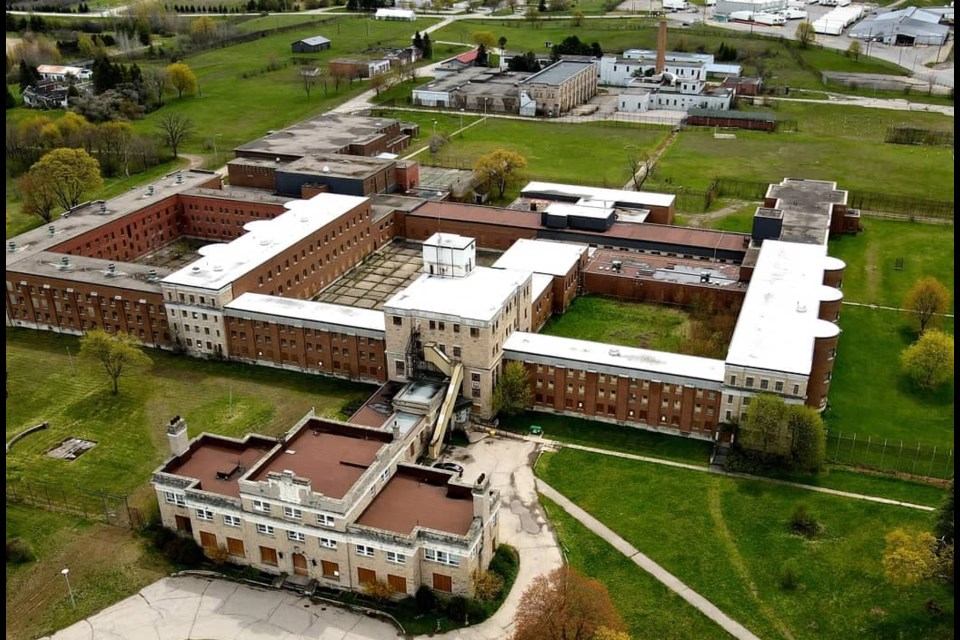Correction: A previous version of this story incorrectly identified the HCD boundary. It also stated that the creek and waterfalls along York Road were excluded from the HCD boundary, which they are not. The excluded wetlands are along Watson Parkway South.
In an effort to preserve what’s left of the former reformatory buildings and their surrounding features, city council unanimously approved the boundary of a planned heritage conservation district on Tuesday evening.
That’s a precursor to formally designating the site for protection under the Ontario Heritage Act, though that’s not expected to happen until late next year or early 2025, staff noted.
“It’s this treasure in Guelph,” said Mayor Cam Guthrie of the former reformatory lands, which he admitted he hadn’t fully appreciated in the past. “It’s something I wish I’d known more about much earlier.”
He encouraged people to learn about the history of the site and walk the lands.
“It’s pretty fantastic,” Guthrie added.
The potential HCD includes all of the remaining reformatory lands at 785 York Rd., along with portions of 919 York Rd., the city-owned property at 80 Dunlop Dr. and 328 Victoria Rd. S. A map of the proposed study area is included above.
In general, it runs along York Road on the north end, follows the property line of 785 York Rd. and around the Cargill plant to the east, cuts along the Eramosa River and across the top of exposed quarry faces, then along the west side of a southern access road and across Stone Road East to include the McQuillan’s bowstring bridge.
A recent study of the site confirmed the properties meet the recently revised provincial threshold for an HCD declaration, which comes with regulations regarding new developments, renovations and additions, among other things, intended to preserve heritage features.
Each of the properties within the set boundary meet at least two of the province’s nine criteria, consultant Joel Konrad told council.
“The area consists of built features, including approximately 43 buildings, as well as associated designed landscape features, including but not limited to public grounds, pathways, hilly landscapes, stone walls, fences, stairs and gates, terraced gardens, ponds, bridges, watercourses, gateposts, and mature planted trees,” the consultant’s report states.
“Most of the extant heritage attributes of the former Ontario Reformatory are located at 785 York Road and most of the extant heritage attributes of the former land use include a mix of built and designed landscape features.”
In 2008, 785 York Rd. was declared a Heritage Property of Provincial Significance.
City council designated the property under Part IV of the Ontario Heritage Act in 2021. Part IV designation offers protection for identified heritage features of built structures.
The process underway now is for a Part V designation, which offers protection for a geographic area, including its landscape, views, natural spaces and relationship between elements.
However, even if council ultimately approves the designation, Bill 23 gave the Minister of Tourism, Culture and Sport the ability to override heritage rules for provincially-owned properties.
Asked by Coun. Cathy Downer what’s happening with the creek and water features along York Road, Krista Walkey, the city’s general manager of planning and building services, explained they’re included in an environmental assessment currently underway as part of a project to widen that section of York Road.
That assessment could result in recommendations for the waterway and features to be conserved, maintained or moved, she said.
A previously released draft showed the former Royal City Jaycees Park area excluded from the study area but it was added in.
The former park area “contains some cultural heritage value in its built heritage features such as a stone/concrete weir and stone-lined edge in that part of Clythe Creek,” noted a recent city staff presentation to Heritage Guelph.
That site was last used as a city park in 2014.
During its meeting last month, Heritage Guelph approved a motion supporting the staff-recommended boundaries, which have also been publicly supported by Yorklands Green Hub, a non-profit corporation dedicated to the repurposing of part of the former reformatory and creation of a sustainable environment centre on the property.
City council endorsed the idea of a HCD study for the former reformatory property in June of 2021. It also agreed to designate individual features of 785 York Rd. under Part IV of the Ontario Heritage Act at that time.
The former Guelph reformatory lands consist of about 222 acres of land that include a set of buildings constructed in the 1910s and 1920s for detention and rehabilitation purposes.
Though the province still owns much of the original reformatory property, it no longer owns all of it. Through the years parcels have been sold off, with pieces now owned by the City of Guelph, along with Cargill Meat Solutions.
The reformatory was fully decommissioned in 2001 and the property has been vacant since 2014, when the Ministry of Community Safety and Correctional Services completely left the site.
